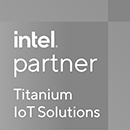NViS 66162: Revolutionizing Workstation NVRs for Enhanced Video Processing and Analytics
TrendIn the Workstation network video recorder (NVR) market, customers are no longer solely concerned with CPU performance and the number of cameras a system can support. Nowadays, they are also interested in the system’s ability to perform streaming analytic tasks while supporting a certain number of cameras. Therefore, it is important to consider whether it’s possible to enhance the AI NVR’s video streaming processing capabilities, such as by adding an image accelerator card (graphic card). Additionally, having a high-performance CPU with better optimization for running and executing demands can meet customers’ high expectations. Finally, NVMe has become increasingly popular in recent years due to the high demand for low latency and high-speed data transmission for software operating of data access.
|
 |

Challenge
Intel’s CPU design featured a single code with multithreading, with no significant difference between big and small cores. As a result, it’s challenging for software developers to optimize execution. Moreover, network video recorder systems with built-in PoE ports often have limited space, making it difficult to add an additional video accelerator card. To address this issue, it’s essential to support rackmount and wall mount installations in the Workstation NVR market. In software development, developers prefer to execute high-speed and low-latency data access directly through NVMe on the CPU pipeline. However, the previous design required the use of a PCIe x16 pipeline on the CPU to import NVMe design, forcing developers to choose between installing a PCIe x16 graphic card or NVMe.
Solution
With the evolution of generations and the gradual maturation of microarchitecture, 12th Gen Intel® Core™ processor represent a significant change in CPUs. They utilize a mixture of performance and efficiency cores, offering a CPU hybrid “big.LITTLE architecture,” which benefits the scheduler in handling complex, multicore workloads and allows the cores to be managed efficiently. Performance tests conducted between the Intel® Xeon® E-2278GE and Intel® Core™ i9-12900E are shown in Table I.
TABLE I
BENCHMARK BY WINDOWS 10 + PASSMARK-PERFORMANCE TEST 10.2
|
Intel® Xeon® E-2278GE
(Intel® Coffee Lake-S) |
Intel® Core™ i9-12900E
(Intel® Alder Lake-S) |
||
|
PassMark-Performance
|
|||
|
Pass Mark Rating
|
3160.9
|
Pass Mark Rating
|
3982.2
|
|
CPU Mark
|
13694.4
|
CPU Mark
|
30780.3
|
|
2D Graphics Mark
|
359.5
|
2D Graphics Mark
|
399.8
|
|
3D Graphics Mark
|
1355.3
|
3D Graphics Mark
|
1876.4
|
|
Memory Mark
|
2834.4
|
Memory Mark
|
3437.1
|
|
Disk Mark
|
20290.3
|
Disk Mark
|
24023.5
|
Based on the performance test results above, the new Intel® Core™ i9-12900E claims to offer 25% better performance compared to the Intel® Xeon® E-2278GE. Additionally, its graphic decoding capabilities enable nearly double the real-time display performance. Table II displays the test results for real-time display performance between the Intel® Xeon® E-2278GE with Intel® UHD Graphics 630 and the Intel® Core™ i9-12900E with Intel® UHD Graphics 770.
TABLE II
BENCHMARK BY WINDOWS 10 + GEEKS FURMARK-PERFORMANCE
|
Intel® Xeon® E-2278GE/
Intel® UHD Graphics 630 (Intel® Coffee Lake-S) |
Intel® Core™ i9-12900E/
Intel® UHD Graphics 770 (Intel® Alder Lake-S) |
||
|
Geeks Furmark-Performance
|
|||
|
Test@720P
|
Test@1080P
|
Test@720P
|
Test@1080P
|
|
15 FPS
Score: 897 |
9 FPS
Score: 526 |
27 FPS
Score: 1588 |
16 FPS
Score: 915 |
Furthermore, the new design of Intel® Core™ i9-12900E has made significant improvements to the CPU PCIe pipeline. It now offers a mixture of PCIe x16 and PCIe x4 interfaces, which allows for the addition of an accelerator card with a PCIe x16 slot and an additional NVMe support. This new technology enhances NVMe performance achieving PCIe Gen4 x4 support, resulting in a performance that is twice as fast when compared to generation PCIe Gen3. The test results for the performance of the new design’s PCIe Gen4 4.0 versus PCIe Gen3 2.0 are shown in Table III.
TABLE III
BENCHMARK BY WINDOWS 10 + CRYSTAL DISK MARK 5.2.1
|
WD SN740 NVMe SSD
M.2 2280 Key M PCle Gen4 x4 |
Intel® Xeon® E-2278GE
(Intel® Coffee Lake-S) |
Intel® Core™ i9-12900E
(Intel® Alder Lake-S) |
||
|
WD SDDPNQD-256G
|
Read [MB/s]
|
Write [MB/s]
|
Read [MB/s]
|
Write [MB/s]
|
|
Seq Q32T1
|
3565
|
1980
|
4081
|
2026
|
|
4K Q32T1
|
350.2
|
176.2
|
887
|
1166
|
|
Seq
|
2756
|
1979
|
3613
|
2026
|
|
4K
|
70.17
|
148.8
|
87.44
|
317.6
|
Conclusion
The new Intel® Core™ i9-12900E CPU offers a significant improvement in overall performance. The CPU features thread director technology, which allows for partial control of the OS scheduler. This makes software development more energy-efficient and power-saving when executing application arrangements. The GPU is equipped with Intel's latest Intel® UHD Graphics 770, and as a whole, the display acceleration is significantly enhanced. This will take workstation network video recorders to another level, allowing them to focus not only on video recording and display functions but also on enabling developers to incorporate more video stream analysis capabilities, thus increasing their value. The NEXCOM NViS 66162 NVR has an advantage in breaking through the limitation of the workstation and creating its value.

- Related Links:
- NViS 6708: The Next Generation of Surveillance Storage - A 2U Rackmount Workstation NVR with High Storage Capacity and High-Speed Storage
- A Powerful 1U Rackmount NVR with Optimized PoE Management Powered by Intel’s 14th Gen Core-i processor
- Browse Other News:
- Urban PET Recycling Reinvented Sustainable Solutions Powered by NDiS B561
- AIEdge-X®80 Leaps Ahead: Power Up TOPS Performance with NVIDIA® Jetson™ Super Mode
- All White Papers News
